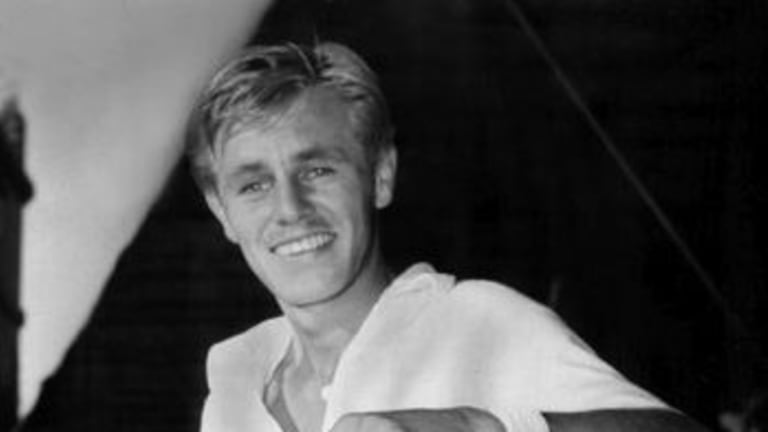“Tennis lost its most colorful character.”
These words were written by former player Bill Talbert, about the 1957 motorcycle accident that prematurely ended the tennis career of his fellow American Art Larsen. They could have been written again 55 years later, in December 2012, when Larsen died at the age of 87.
In the obituaries and tributes that followed, Larsen was remembered as a character in full. The California native was, according to the New York Times, “a smoker, a drinker, and a partygoer.” Asked if Larsen had a disdain for training, his friend and rival Dick Savitt laughed and said, “That’s the understatement of a lifetime. I don’t think he knew what the word ‘training’ was.”
Savitt said the first time he met him, Larsen walked on court “wearing long pants with his pockets bulging with cigarettes...” Still, he knew from experience that Larsen, who was the top-ranked American in 1950, the same year he won the Nationals at Forest Hills, was in “great shape” and “could play all day.”
Larsen wasn’t just unique in his practice habits. His quirks were even more pronounced on court. There he was a jumble of superstitions, never stepping on a line and always finding a moment to nudge the net with his racquet—his nickname was Tappy, because he tapped everything in sight, including his friends. He tried to serve with the ball that had been used to win the previous point, and he smiled at birds that flew over the court, believing that they brought him good luck. He was always on the lookout for eagles, an especially good omen.
But most of the tributes to Tappy left out two important elements of his life and career: (1) His talent with a tennis racquet, which was equally occult, and (2) the reason he became the way he did in the first place, his traumatic and death-defying stint in World War II.
In his memoir of the amateur tour of the 1950s and 60s, A Handful of Summers, fellow player Gordon Forbes described Larsen’s game much the way John McEnroe’s would be described 30 years later.
Larsen was "a natural left-handed player of almost uncanny ability,” wrote Forbes, who claimed that tennis in the 1950s was so chock full of oddballs that he came to believe that, “to reach the top of the game, you had to be slightly touched.”
Still, no one combined strangeness with skill quite like Larsen. “He had that rare gift enjoyed by only a very few tennis players—a perfect touch, a feel for the ball, an inner knowledge of exactly what was going on between the strings of his racquet and the cloth attached to the rubber inside of the ball.”
Like many gifted talents before and since, Larsen wasn’t satisfied with winning a point in a straightforward way. “There’s no fun going about killing balls like a butcher,” he would say. In the early 50s, Forbes teamed up with Larsen to reach the doubles final at a tournament in Paris. At set point in the third set, Larsen had an easy putaway at the net. Forbes watched in horror as Tappy, instead of belting a conventional overhead, started his wind up and then, at the last second, turned his frame around and used the butt cap to drop the ball an inch over the net for a winner.
“Scared you badly, eh kid?” a grinning Larsen said to the younger, and much more anxious, Forbes. “Thought I was going to foul it up, eh?” Then Larsen “laughed the happy laugh that he used when things were going according to plan.”
While he had a mercurial streak, and wasn’t always polite with ball boys, Tappy’s fellow players “loved him to the point of adoration never missed watching his matches,” according to Forbes. To everyone in the game at the time, Larsen’s accident—he was left partly paralyzed after crashing on an Italian scooter that he had won in a tournament—was a tragedy.
Art Larsen was the patron saint of nutty tennis talents, but he was also a member of another tribe within the sport, one that has dwindled to the point of extinction: World War II veterans. During his three years in the army, Larsen saw more action than most, and more than he cared to remember.
He landed at Omaha Beach on D-Day. After watching most of his friends die there, Larsen, as a tommy-gunner, fought his way inland. “Suddenly,” he said, “out of nowhere, a fleet of bombers began strafing and bombing us. Our own Air Force had mistaken us for Nazis. Half the troops were killed, ambulances were lined up for miles. I came through unscratched. Then and there I developed the complexes I’m still trying to shake.”
Larsen only took up the game seriously on doctor’s orders after the war. “I was so nervous and shell-shocked, that the exercise in the open air, through tennis, was the only thing that cured me.”
The International Tennis Hall of Fame, which inducted him in 1969, reported that Larsen died on December 7th, 2012, though because of a delay in the announcement, the tributes to him didn’t begin to turn up until just before New Year’s. It was, in its melancholy way, a fitting way for one tennis season to end and another to begin.
Larsen’s death, which came three years after his fellow California native and war veteran Jack Kramer’s, took one more member of American tennis's Greatest Generation from us. We like to talk about athletes as “warriors” these days; in his bravery and his fragility, Larsen was the real thing. But Tappy wasn’t the last we’ll see of his type of player. He was a reminder of how a tennis court will always be a place of refuge for the artist, the odd man out, the strange genius, the determined individual.
